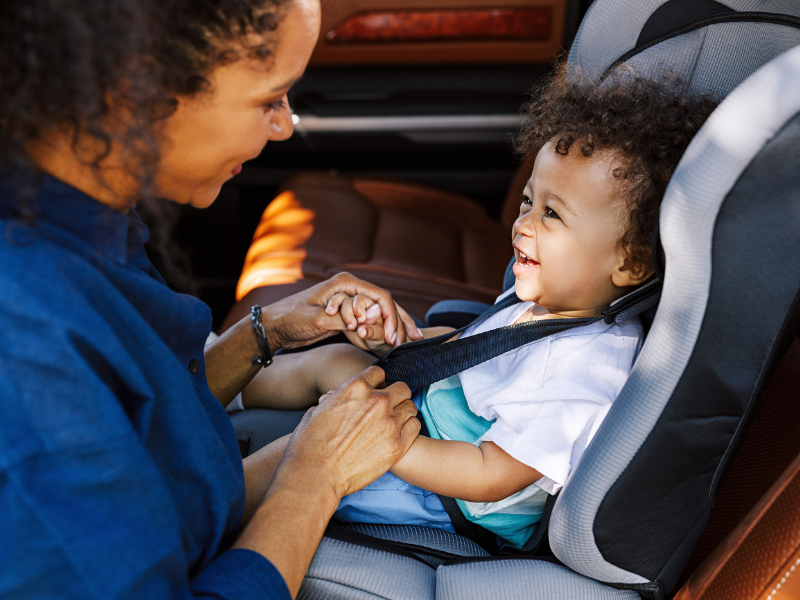Protect Your Child During Every Safety Seat Stage
During the week of September 18-24, 2022 caregivers throughout the country will see and hear an increase in messages about the importance of correctly using car seats or boosters seats to best protect children from injuries and death as a result of crashes, as part of National Child Passenger Safety Week. The dedicated week is used to educate caregivers how to best protect their children during every safety stage in the vehicle.
The four stages for child safety are: rear-facing, forward-facing with harness, booster seat and seat belt
Early Rear-Facing is Critical
That first, rear-facing stage is incredibly vital to a child’s safety in a crash. Starting October 1, 2022, Maryland will add a rear-facing provision to its Child Passenger Safety Law that states all children under age 2 must ride rear-facing, per the car and vehicle instructions.
This means that children who initially ride in rear-facing only car seats will upgrade to a rear-facing convertible or all-in-one style car seat until a minimum of age 2, as these style car seats can accommodate children to 40-50 pounds, depending upon the car seat. You can and should keep a child rear-facing longer than age 2 if s/he fits the rear-facing car seat specs, but the law will require a minimum of age 2 before a child may be turned forward-facing.
- Why rear-facing so long?
The rear-facing car seat best protects a child’s head, neck and spinal cord by holding the child down in the car seat during an emergency and allowing the car seat shell to absorb the crash energy. Some call it a “turtle shell” effect or like “catching a ball in a catcher’s mitt.” Kids In Safety Seats calls it the gold star standard for safety when addressing our youngest, and most vulnerable, passengers. Broken bones can be fixed but injuries to the brain or spinal cord most often cannot be fixed to the same quality of life, so the focus of extended rear-facing car seats is to protect those vulnerable areas from injury.
- Worried about their feet/legs getting crushed as they get older?
You don’t need to! By the nature of a crash, a child’s arms and legs will draw closer to their body as the car seat moves, and children are super flexible, so they bend more easily at the joints, providing excellent protection of their extremities. In fact, there is an increased likelihood of arm or leg injuries when turned forward-facing, as children’s arms and legs will flail about and hit into the vehicle interior instead of curling up inside their “turtle shell.”
Forward-Facing with Harness
Once a child has outgrown the rear-facing car seat (and after age 2!), parents can move their child to a forward-facing car seat with a harness. This type of seat holds the child back against the car seat to minimize injury. It is important to use the forward-facing harness to the maximum weight of height allowed by the car seat before graduating into the booster seat.
Booster Seat to Adult Seat Belt
A booster seat is Stage 3, and the purpose of the booster seat is to physically raise the small-framed child up into the adult-sized seat belt. Children should ride in a booster seat until Stage 4, when they correctly fit the adult seat belt (lap belt low over the hips/upper thigh area and shoulder belt centered at the collarbone). Most children need a booster seat until 10-12 years old.
Maryland has a variety of free activities scheduled for National Child Passenger Safety Week, including webinars and both in-person and virtual car seat checks. To view the lists of activities, visit mdkiss.org and click on, “Webinars and Car Seat Events.”
Additional Child Passenger Safety Resources
The Governors Highway Safety Association provides a searchable chart of statewide laws related to child passenger safety across the U.S., including D.C., Maryland and Virginia.
Safekids.org has a locator of car seat safety inspection stations by state and additional car safety seat links
The NHTSA (National Highway Traffic Safety Administration) website has a section on car seats and booster seats that includes finding the right car seat and installation help, a used car seat safety checklist.
District Department of Transportation Car Safety Seat Program offers car seat safety information in English and Spanish
The DC Metropolitan Police Department has a great list of helpful links related to child car seat safety.
The Virginia Department of Health website’s Child Passenger Safety section includes related state laws, car seat installation videos, information on pregnancy and seat belts, and a day-by-day list of places to get safety seat checks.
Related


